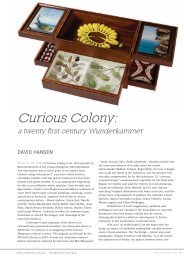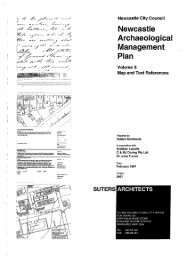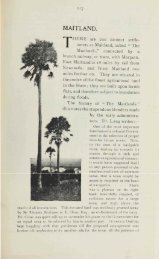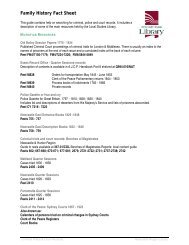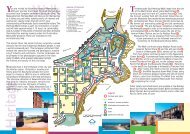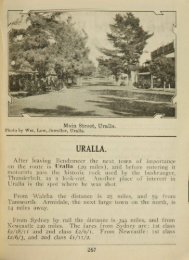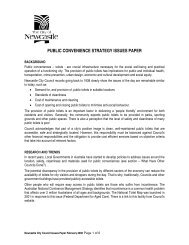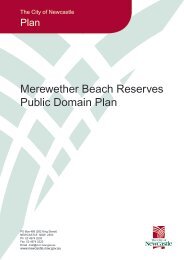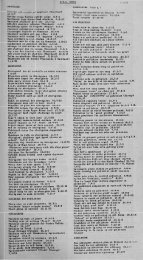Part Two – post 1920s - Newcastle City Council
Part Two – post 1920s - Newcastle City Council
Part Two – post 1920s - Newcastle City Council
Create successful ePaper yourself
Turn your PDF publications into a flip-book with our unique Google optimized e-Paper software.
the Sydney Symphony Orchestra visited <strong>Newcastle</strong> it was usually necessary for them<br />
to use the Century Theatre at Broadmeadow.<br />
Plans, ideas and debate in the 1940s and1950s about civic precinct land involved the<br />
Greater <strong>Newcastle</strong> <strong>Council</strong>, the Northumberland County <strong>Council</strong> and the community.<br />
The various proposals have already been mentioned. The council began to resume its<br />
preferred site, which was the land section bounded by Laman, Dawson, Queen and<br />
Darby Streets. Opposition came from those who lived in the cottages thereon and<br />
other residents and aldermen who supported them and those who opposed the cultural<br />
centre project in general. Housing was in short supply in the <strong>post</strong>-war years and the<br />
social and economic distress argument could not be ignored. Displaced residents<br />
were subsequently relocated in alternate housing.<br />
In 1946 a salaried financial organiser and assistant were appointed to seek funding for<br />
the cultural centre. At the time donations were not ‘tax deductible’. Amending this<br />
law took until early 1947. The Minister for Education the Hon J R Heffron MLA was<br />
then invited to open the fund raising appeal. His acceptance indicated that the<br />
government viewed the cultural centre favourably. This was subsequently confirmed<br />
when the State Conservatorium of Music was placed under the administration of the<br />
Department of Education.<br />
As soon as funds began to accumulate, with large sums contributed by industry,<br />
commerce, groups and individuals, the government responded with promised<br />
subsidies. Achieving the cultural centre was now assured, as was the setting up<br />
therein of a branch of the State Conservatorium.<br />
In order to help meet the demand for music tuition a temporary conservatorium was<br />
set up in 1951 in a timber barrack-type building in King Street at the eastern end of<br />
Civic Park. (In 1951 about 60 students from <strong>Newcastle</strong> were travelling to Sydney for<br />
music lessons.) Teaching commenced here in early 1952. 165 students enrolled in<br />
the first week. By the end of the first year, 388 students had enrolled and in the<br />
subsequent years of 1953 and 1954, 562 and 608 students enrolled. Conditions in the<br />
temporary building became congested. The sound of music making overflowed into<br />
Civic Park attracting the attention of passers-by. The success of the temporary<br />
conservatorium justified the establishment of a permanent music school in <strong>Newcastle</strong><br />
and the continued effort of its supporters. The principal of the conservatorium<br />
initiated a scheme to raise funds for scholarships.<br />
The temporary conservatorium can be seen in the 1960s aerial view of the civic<br />
precinct, Figure 36.<br />
The Cultural Centre Committee continued their work. Apparently there were times<br />
when ‘local politics’ was near to excluding the conservatorium from the plan. Many<br />
negotiations ensued to keep it in, and after the official opening the music school<br />
moved into the third floor. The new building provided improved facilities, 13 large<br />
studios, a large lecture room and small hall capable of seating 40 and 90 respectively,<br />
a library and administrative offices, but no auditorium.<br />
The conservatorium made remarkable growth and established important links with<br />
education, teacher training and the New South Wales University of Technology - the<br />
forerunner of the University of <strong>Newcastle</strong>, laying the foundation for <strong>Newcastle</strong>’s<br />
standing today as a significant centre of tertiary education in New South Wales.<br />
<strong>Newcastle</strong> Civic and Cultural Precinct History ~ Cynthia Hunter ~ January 2003 page 42




